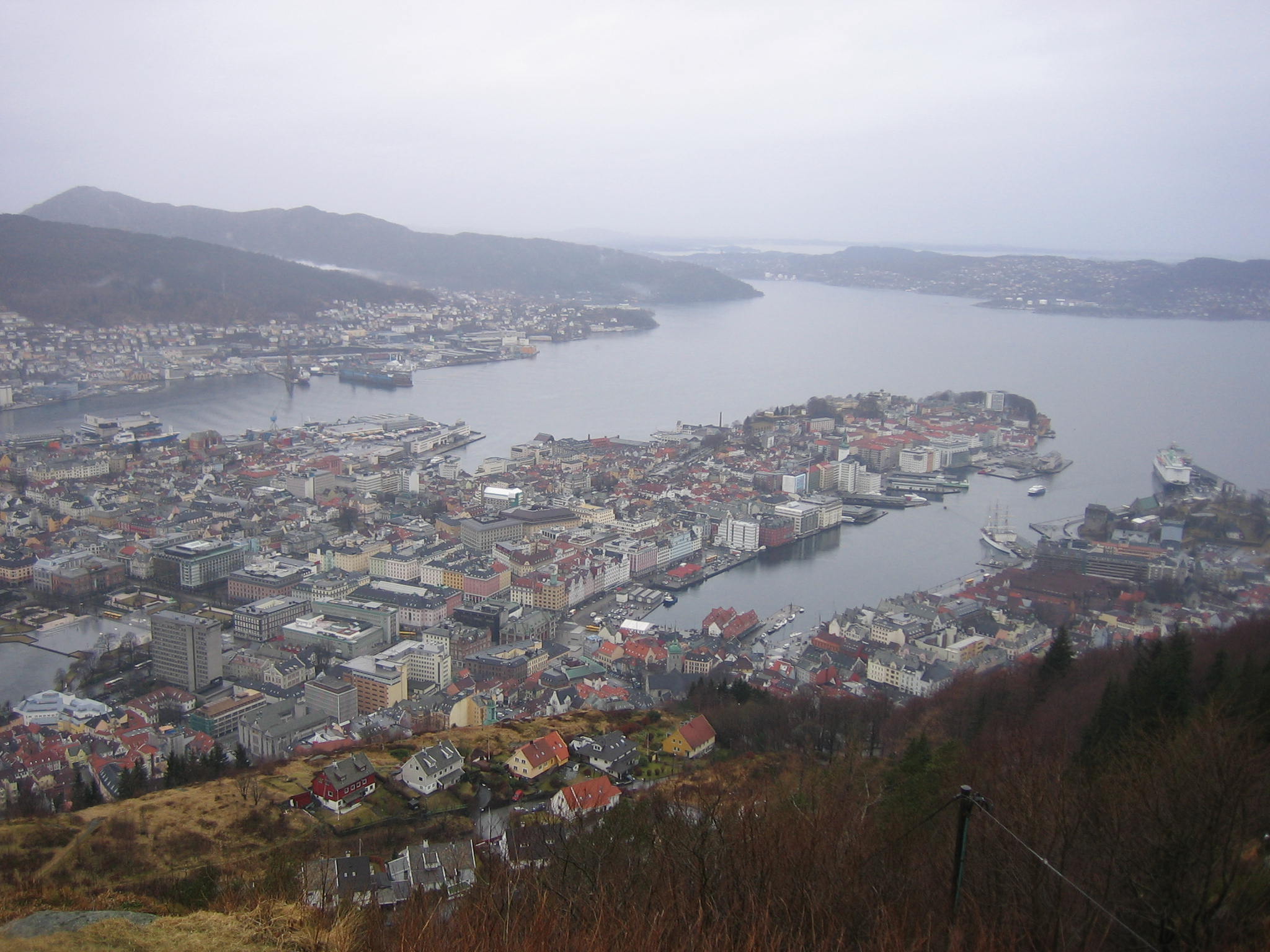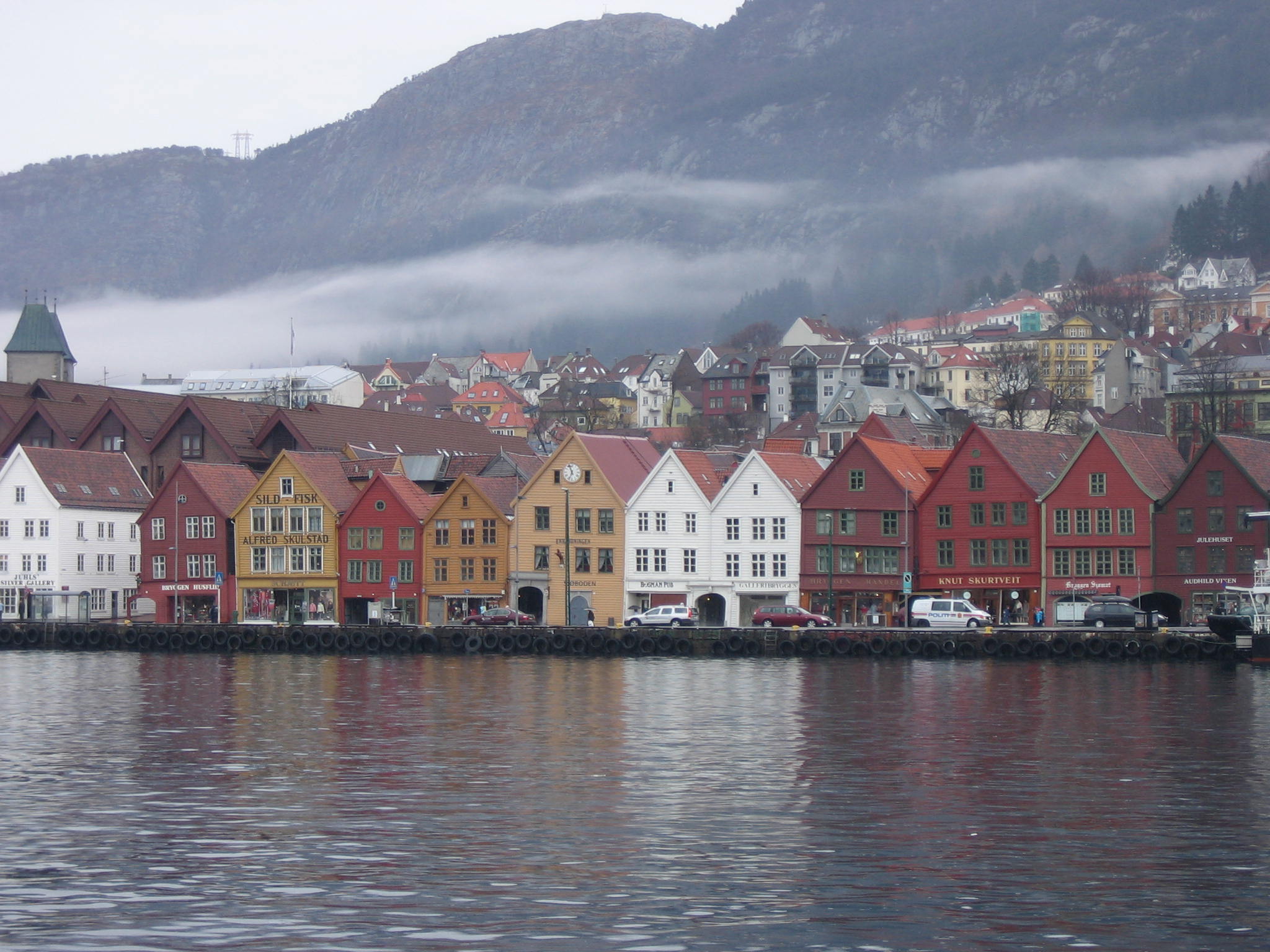Bergen-the meadow among the mountains Posted by kari on Jun 18, 2009 in Uncategorized

 Situated in probably my favorite part of Norway, Bergen got it’s name from the old Norse words “berg” or ”bjørg” (both meaning hill or mountain) and ”vin” (a word which now is the word for wine, but in old Norse meant meadow or pasture). Bergen is situated among what are known as ”de syv fjell,” which means the seven mountains. Most of you learn the number 7 is ”sju,” but in Bergen, where many people still speak a conservative ”riksmål” or ”byspråk,” an urban or city langugage kept alive in Bergen in order to avoid the influence of urban Danish. So syv is 7. I will dedicate another post to clarifying the Norwegian language and it’s many influences and forms.
Situated in probably my favorite part of Norway, Bergen got it’s name from the old Norse words “berg” or ”bjørg” (both meaning hill or mountain) and ”vin” (a word which now is the word for wine, but in old Norse meant meadow or pasture). Bergen is situated among what are known as ”de syv fjell,” which means the seven mountains. Most of you learn the number 7 is ”sju,” but in Bergen, where many people still speak a conservative ”riksmål” or ”byspråk,” an urban or city langugage kept alive in Bergen in order to avoid the influence of urban Danish. So syv is 7. I will dedicate another post to clarifying the Norwegian language and it’s many influences and forms.
Which 7 mountains the city is known for is contested, but the following are definitely included: Ulriken, Fløyen, Løvstakken, and Damgårdsfjellet. The other 3 are among the following: Lyderhorn, Sandviksfjellet, Blåmanen, Rundemanen, and Askøyfjellet. These mountains are only just a few of the mountains around Bergen.�
Bergen is the second largest city in Norway (with about 252,000 inhabitants, although if you count the greater Bergen area there are roughly 385,000 people) and is the administrative center of Hordaland fylke (county). There are nitten (19) fylker in Norway altogether. Of all the citites in Europe, Bergen is one of 9 cities that proudly bore the title of ”European Capital of Culture” in 2000 (cities designated by the European Union for one calendar year to show off the culture). Hurrah for Bergen!
A brief synoposis of the history of this fine city…it is thought to have been founded by Olav Kyrre in 1070 AD. It actually was the capital of Norway for a stint in time (in between the first capital, Trondheim, and the current capital, Oslo. During the late 13th century, Bergen became one of the most important cities in the Hanseatic League (an alliance of trading cities and their guilds all along the coast from the Baltic to the North Sea). Bergen traded mostly cod brought down from northern Norway. During this high time for Bergen as a hub for the Hanseatic Leauge, a certain part of the city housed men who spoke a form of German.�
Another pretty important blip in Bergen’s history is the arrival of the Svartedauden (Black Death or bubonic plague) by an English ship in 1349. This plague killed 30-60 % of the population of Europe. Between 1350 and 1550 in Norway, research shows that the population declined as much as 65%.
As long as we are on the subject of devastation, there have been many serious fires in Bergen because most houses were made of wood, one of which occured in 1955 and destroyed part of one of the most well-known parts of the city-Bryggen or Tyskebryggen (the German wharf) – a series of buildings that the Hanseatic League occupied during it’s existence.
There is much more I could write about Bergen, but that will have to wait til a later post. If you go to Norway, you absolutely cannot skip this city. It’s not even that there is that much to DO in Bergen, but to be there and experience the fjords and the mountains is spectacular. Take a ride up Fløybanen, a funicular that takes you to the top of mount Fløyen, where you can hike around, take beautiful pictures of the city and sea below, and enjoy a meal!

Build vocabulary, practice pronunciation, and more with Transparent Language Online. Available anytime, anywhere, on any device.
About the Author: kari
I attended St. Olaf College in Northfield, MN, where I majored in Norwegian and History. During college, I spent almost a year living in Oslo, Norway, where I attended the University of Oslo and completed an internship at the United States Embassy. I have worked for Concordia Language Villages as a pre-K Norwegian teacher and have taught an adult Norwegian language class. Right now, I keep up by writing this Norwegian blog for Transparent Language. Please read and share your thoughts! I will be continuing this blog from my future residence in the Norwegian arctic!




Comments:
Julia Graves:
I passed through Bergen on my way from the UK to Stongfjorden and was very impressed. I would love to go back and spend some time in and around the city now that I speak a little Norwegian. I’m also very tempted by the sound of the Bergen-Oslo railway, which I’ve heard is spectacular.
Greta:
Thank you for the article on Bergen, a town that I love to visit too. ( I live in Oslo.)
But I have to correct you on the explanation to the word SYV for seven in the Bergen language. (De syv fjell). This is certainly NOT nynorsk (New Norwegian)! It is concervative “riksmål” – which has survived in all the larger towns in Norway as spoken language. It is often called “byspråk” (urban or town language) in Norwegian linguistics. It is the older Danish influenced language that has survived more easily in urban areas. It is true that nynorsk is common in most of the western parts of Norway, but Bergen is a typical “island” with its Bergensk byspråk. SJU is nynorsk, SYV – from danish – is still allowed in bokmål, but bokmål has through the years parted more and more from the urban “riksmål” and adopted more words of Norwegian origin, similar to New Norwegian.
The true Bergenser would not be happy to hear that New Norwegian is his or her language! They are very proud of their concervative language and never use female gender for instance, as in Danish. Even the word for a girl in the Bergen language is EN JENTE – JENTEN – male gender. It was in order to save the Norwegian language from the urban influences of Danish that Ivar Aasen constructed the New Norwegian language, which was for decades called “landsmål” – country language.
Beth Tom:
I named my daughter Bergen. Our ancestry traces back to the early Norse and Viking heritage. Her name is perfect for her. I knew innately that this should be her name. I can not explain why….
Bjørn A. Bojesen:
@Beth Tom @Beth – I’m happy you found a nice name for your daughter! I must admit, though, this is the first time I hear that name used for a human being. That’s quite interesting. 🙂 Lots of luck to you both.